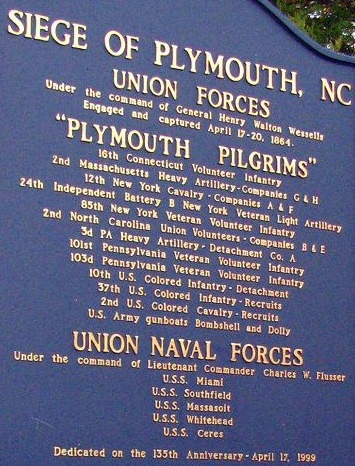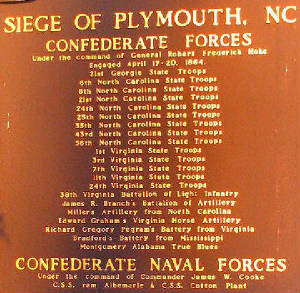|
| Battle of Plymouth |

|
| Union Forces |
Union Forces
Union Order of Battle
1st North Carolina Union Volunteers
2nd North Carolina Union Volunteers
101st Pennsylvania Volunteers
103rd Pennsylvania Volunteers
16th Connecticut Infantry
85th New York Light Infantry
10th US Colored Infantry
37th US Colored Infantry
2nd US Colored Cavalry
12th New York Cavalry
2nd Massachusetts Heavy Artillery
24th
New York Independent Battery
Naval
USS Miami
USS Southfield
USS Ceres
USS Whitehead
USS Massasoit
Confederate Order of Battle
Hoke's Brigade
6th North Carolina Infantry
21st North Carolina Infantry
43rd North Carolina
Infantry
54th North Carolina Infantry
21st Georgia Infantry
Ransom's Brigade
8th North Carolina Infantry
24th North Carolina Infantry
25th North Carolina Infantry
35th North Carolina Infantry
49th North Carolina Infantry
56th North Carolina Infantry
| Battle of Plymouth |

|
| Confederate Forces |
Kemper's Brigade
1st Virginia Infantry
3rd Virginia Infantry
7th
Virginia Infantry
11th Virginia Infantry
24th Virginia Infantry
Dearing's Battalion
8th Confederate Cavalry
Virginia Horse Artillery
Branch's Battalion
Pegram's Battery
Miller's Artillery
Bradford's Battery
Moseley's Battalion
Montgomery (Alabama) True Blues Infantry
Wilmington Light Artillery
Guion's Battalion
1st NC Artillery - Co.s B, G & H.
Read's Battalion
38th Virginia Battalion of Light Infantry
Fauquier Artillery (Co. A)
Richmond Fayette Artillery (Co. B)
Bloundt's Lynchburg Artillery (Co. D)
Naval
Source: Official Records of the Union and Confederate Armies
Recommended
Reading: Battle of Plymouth, North Carolina
(April 17-20, 1864): The Last Confederate Victory, by Juanita Patience Moss. Description: Are you familiar with the Battle of Plymouth? Not Plymouth, Massachusetts,
but how about Plymouth,
North Carolina? If you have never
heard of it, you are in the company of many others, even those who consider themselves avid Civil War buffs. The Battle of
Plymouth took place April 17-20, 1864, during the “Operations against Plymouth,”
and even though the engagement was one year before Lee surrendered to Grant, the sounds of America’s costliest and bloodiest conflict would yield havoc on
North Carolina’s
coastal communities. Continued below…
In this fascinating
book, you will read about the second largest battle in North Carolina
and it was fought at a small North Carolina coastal town
named Plymouth,
where the Confederates tasted their last victory. Intense action transpired during those four days, and the atmosphere was
filled with surprise, fate, intrigue, bravery, ingenuity, hope, daring, dedication, gallantry, victory, disappointment, and
defeat. The battle witnessed the likes of Cooke, Cushing, Flusser, Hoke, and Wessells, and the formidable CSS Albemarle, an
ironclad warship that was not built in the traditional shipyard, but rather in a Southern cornfield. The battle epitomized
the brothers’ war, with North Carolina Federal regiments fighting their North Carolina Confederate brethren; it also
witnessed African American regiments (USCT) in the thick of the fight. The combined Union
and Confederate casualties were just shy of 3,000, and the author offers an informative, enlightening, and interesting view
of the “Last Confederate Victory." Although a bit repetitive, it is a worthy addition because
it is the only full-length text dedicated to the battle. It is a welcome addition to North Carolina
and school libraries, and to the buff that enjoys reading about the lesser-known Civil War battles and it troops (Union and Confederate) that fought valiantly. Three stars.
Recommended Reading: The Civil War in the Carolinas
(Hardcover). Description: Dan Morrill relates the experience
of two quite different states bound together in the defense of the Confederacy, using letters, diaries, memoirs, and reports.
He shows how the innovative operations of the Union army and navy along the coast and in
the bays and rivers of the Carolinas affected the general course of the war as well as the
daily lives of all Carolinians. He demonstrates the "total war" for North Carolina's
vital coastal railroads and ports. In the latter part of the war, he describes how Sherman's operation cut out the heart of the last stronghold of the South. Continued below...
The author offers fascinating sketches of major and minor
personalities, including the new president and state governors, Generals Lee, Beauregard, Pickett, Sherman, D.H. Hill, and
Joseph E. Johnston. Rebels and abolitionists, pacifists and unionists, slaves and freed men and women, all influential, all
placed in their context with clear-eyed precision. If he were wielding a needle instead of a pen, his tapestry would offer
us a complete picture of a people at war. Midwest
Book Review: The Civil War in the Carolinas by civil war expert and historian Dan Morrill (History Department, University
of North Carolina at Charlotte, and Director of the Charlotte-Mecklenburg Historical Society) is a dramatically presented
and extensively researched survey and analysis of the impact the American Civil War had upon the states of North Carolina
and South Carolina, and the people who called these states their home. A meticulous, scholarly, and thoroughly engaging examination
of the details of history and the sweeping change that the war wrought for everyone, The Civil War In The Carolinas is a welcome
and informative addition to American Civil War Studies reference collections.
Recommended Reading:
The Civil War in Coastal North Carolina (175 pages) (North Carolina Division
of Archives and History). Description: From the drama
of blockade-running to graphic descriptions of battles on the state's islands and sounds, this book portrays the explosive
events that took place in North Carolina's coastal region during the Civil War. Topics discussed include the strategic
importance of coastal North Carolina, Federal occupation
of coastal areas, blockade-running, and the impact of war on civilians along the Tar Heel coast.
Recommended Reading: Ironclads and Columbiads: The Coast
(The Civil War in North Carolina) (456 pages). Description: Ironclads and Columbiads covers some of the most
important battles and campaigns in the state. In January 1862, Union forces began in earnest to occupy crucial points on the
North Carolina coast. Within six months, Union army and
naval forces effectively controlled coastal North Carolina from the Virginia
line south to present-day Morehead City.
Union setbacks in Virginia, however, led to the withdrawal of many federal soldiers from North Carolina, leaving only enough
Union troops to hold a few coastal strongholds—the vital ports and railroad junctions. The South during the Civil War,
moreover, hotly contested the North’s ability to maintain its grip on these key coastal strongholds.
Recommended
Reading: Iron Afloat: The Story of the Confederate Armorclads. Description: William N. Still's book is rightfully referred to as the standard of Confederate Naval history.
Accurate and objective accounts of the major and even minor engagements with Union forces are combined with extensive background
information. This edition has an enlarged section of historical drawings and sketches. Mr. Still explains the political background
that gave rise to the Confederate Ironclad program and his research is impeccable. An exhaustive literature listing rounds
out this excellent book. While strictly scientific, the inclusion of historical eyewitness accounts and the always fluent
style make this book a joy to read. This book is a great starting point.
Recommended
Reading: A History of the Confederate Navy
(Hardcover). From Publishers Weekly: One of the most prominent European scholars of the Civil War weighs in with a provocative
revisionist study of the Confederacy's naval policies. For 27 years, University of Genoa history professor Luraghi (The Rise
and Fall of the Plantation South) explored archival and monographic sources on both sides of the Atlantic to develop a convincing
argument that the deadliest maritime threat to the South was not, as commonly thought, the Union's blockade but the North's
amphibious and river operations. Confederate Navy Secretary Stephen Mallory, the author shows, thus focused on protecting
the Confederacy's inland waterways and controlling the harbors vital for military imports. Continued below…
As a result,
from Vicksburg
to Savannah to Richmond, major
Confederate ports ultimately were captured from the land and not from the sea, despite the North's overwhelming naval strength.
Luraghi highlights the South's ingenuity in inventing and employing new technologies: the ironclad, the submarine, the torpedo.
He establishes, however, that these innovations were the brainchildren of only a few men, whose work, although brilliant,
couldn't match the resources and might of a major industrial power like the Union. Nor did
the Confederate Navy, weakened through Mallory's administrative inefficiency, compensate with an effective command system.
Enhanced by a translation that retains the verve of the original, Luraghi's study is a notable addition to Civil War maritime
history. Includes numerous photos.
|

